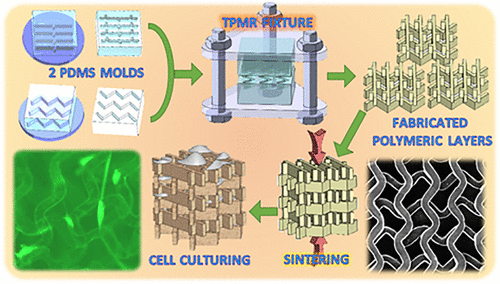当前位置:
X-MOL 学术
›
ACS Biomater. Sci. Eng.
›
论文详情
Our official English website, www.x-mol.net, welcomes your
feedback! (Note: you will need to create a separate account there.)
A Microfabrication Method of PCL Scaffolds for Tissue Engineering by Simultaneous Two PDMS Molds Replication
ACS Biomaterials Science & Engineering ( IF 5.4 ) Pub Date : 2021-09-13 , DOI: 10.1021/acsbiomaterials.1c00651 Hassan Najafi Sani 1 , Karen Abrinia 1 , Nooshin Haghighipour 2 , Daniel George 3 , Yves Remond 3 , Majid Baniassadi 1
ACS Biomaterials Science & Engineering ( IF 5.4 ) Pub Date : 2021-09-13 , DOI: 10.1021/acsbiomaterials.1c00651 Hassan Najafi Sani 1 , Karen Abrinia 1 , Nooshin Haghighipour 2 , Daniel George 3 , Yves Remond 3 , Majid Baniassadi 1
Affiliation

|
Not very far away, “tissue engineering” will become one of the most important branches of medical science for curing many types of diseases. This branch needs the cooperation of a wide range of sciences like medicine, chemistry, cellular biology, and genetic and mechanical engineering. Different parameters affect the final produced tissue, but the most important one is the quality and biocompatibility of the scaffold with the desired tissue which can provide the functionality of “native ECM” as well. The quality of the scaffold is directly dependent on its materials, design, and method of fabrication. As to the design and fabrication, there are two main categories: (a) random microporosity such as phase separation, electrospinning, and fused deposition modeling (3D printing) and (b) designed microporosity mostly achievable by stereo lithography and soft lithography. The method of fabrication implemented in this research is a novel method in soft lithography employing a type of “replica molding” with one pair of polydimethylsiloxane (PDMS) molds in contrast to traditional replica molding with just one single mold. In this operation, the solution of polycaprolactone in chloroform is initially prepared, and one droplet of the solution is placed between the molds while a preset pressure is applied to maintain the molds tightly together during the solidification of the polymer layer and vaporization of the solvent. Thus, a perfect warp and woof pattern is created. In this research, it has been approved that this is a feasible method for creating complex patterns and simple straight fiber patterns with different spacings and pore sizes. Cell attachment and migration was studied to find the optimum pore size. It was shown that the small pore size improves the cells’ adhesion while reducing cell migration capability within the scaffold.
中文翻译:

通过同时两个 PDMS 模具复制的组织工程 PCL 支架的微细加工方法
在不久的将来,“组织工程”将成为治疗多种疾病的医学科学最重要的分支之一。该分支需要医学、化学、细胞生物学、遗传和机械工程等广泛科学领域的合作。不同的参数会影响最终生产的组织,但最重要的是支架与所需组织的质量和生物相容性,这也可以提供“天然 ECM”的功能。支架的质量直接取决于其材料、设计和制造方法。至于设计和制造,有两大类:(a)随机微孔,如相分离、静电纺丝、和熔融沉积建模(3D 打印)和(b)设计的微孔率主要可通过立体光刻和软光刻实现。本研究中实施的制造方法是软光刻中的一种新方法,它采用一种“复制成型”和一对聚二甲基硅氧烷 (PDMS) 模具,而传统的复制成型只有一个模具。在此操作中,首先制备聚己内酯的氯仿溶液,在聚合物层固化和溶剂蒸发过程中,将一滴溶液置于模具之间,同时施加预设压力以保持模具紧密地结合在一起。因此,创建了完美的经纱和纬纱图案。在这项研究中,已经证实,这是一种可行的方法,可以创建具有不同间距和孔径的复杂图案和简单的直纤维图案。研究细胞附着和迁移以找到最佳孔径。结果表明,小孔径提高了细胞的粘附性,同时降低了支架内的细胞迁移能力。
更新日期:2021-10-12
中文翻译:

通过同时两个 PDMS 模具复制的组织工程 PCL 支架的微细加工方法
在不久的将来,“组织工程”将成为治疗多种疾病的医学科学最重要的分支之一。该分支需要医学、化学、细胞生物学、遗传和机械工程等广泛科学领域的合作。不同的参数会影响最终生产的组织,但最重要的是支架与所需组织的质量和生物相容性,这也可以提供“天然 ECM”的功能。支架的质量直接取决于其材料、设计和制造方法。至于设计和制造,有两大类:(a)随机微孔,如相分离、静电纺丝、和熔融沉积建模(3D 打印)和(b)设计的微孔率主要可通过立体光刻和软光刻实现。本研究中实施的制造方法是软光刻中的一种新方法,它采用一种“复制成型”和一对聚二甲基硅氧烷 (PDMS) 模具,而传统的复制成型只有一个模具。在此操作中,首先制备聚己内酯的氯仿溶液,在聚合物层固化和溶剂蒸发过程中,将一滴溶液置于模具之间,同时施加预设压力以保持模具紧密地结合在一起。因此,创建了完美的经纱和纬纱图案。在这项研究中,已经证实,这是一种可行的方法,可以创建具有不同间距和孔径的复杂图案和简单的直纤维图案。研究细胞附着和迁移以找到最佳孔径。结果表明,小孔径提高了细胞的粘附性,同时降低了支架内的细胞迁移能力。











































 京公网安备 11010802027423号
京公网安备 11010802027423号